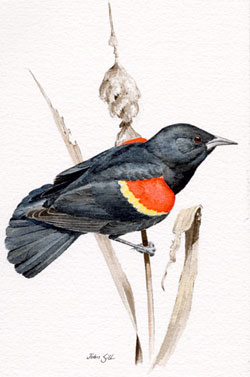Breeding Bird Atlases (BBA)
Find a Bird - BBA1
Breeding Bird Atlas 1 Species Accounts
Red-winged Blackbird
Agelaius phoeniceus
Egg Dates
May 10 to June 21
Number of Broods
one; may renest if first attempt fails.

The Red-winged Blackbird is a common summer resident throughout the state, nesting in the swamps and marshes of river bottoms, the borders of streams and ponds, and sometimes in upland fields. In migration it is locally abundant, occurring in flocks in agricultural areas and other sites.
This bird is one of the earliest to arrive in the spring, with the first flocks often appearing in the last week of February. These early groups are composed almost entirely of adult males. They frequently swoop into the tops of trees and burst forth with a loud bubbling, gurgling chorus of song—a true harbinger of spring. Spring migration of both residents and migrants continues through March into early April. Resident adult males do not take up their territories until about the middle of March. The first females arrive a few weeks later.
Red-winged Blackbirds breed mainly in loose colonies in swamps and marshes. The males stake out territories, which they vigorously and noisily defend. When the females appear, there is much dashing about the marsh as the males give chase. During courtship, the males display the scarlet shoulder patches, or epaulets, by puffing themselves up with wings slightly spread and tail fanned, and they sing the familiar ok-a-lee or conk-a-ree from a prominent perch. Another display is a short vertical flight and a fluttering descent back to the perch. There are a number of other vocalizations. Males give a zeet call quite frequently and a peeah sound when they are alarmed. Nesting females characteristically produce a loud chip-chip-chip-chip series. The common call note is a chuck or check, often heard as the birds fly overhead.
Males are often polygamous and may have two or three mates nesting within their territories. The rather dull, brown-striped female builds the nest of cattails and other marsh vegetation, often suspended over water in the rushes, sedges, cattails, or grasses of the marsh. Sometimes nests are found in bushes or low trees and in some instances in nearby drier uplands. Sixteen Massachusetts nests were located as follows: field (8 nests), marsh (4 nests), woods (3 nests), swamp (1 nest) (CNR). The high number recorded in fields is probably a reflection of the easier accessibility of that site as compared to the wet locations. Of 17 state nests, 7 were on the ground and the others ranged from 1 to 7 feet in height, with an average of 4.6 feet (CNR).
Three to five eggs (sometimes more) may be laid, but the usual clutch consists of four. Clutch sizes for 23 Massachusetts nests were one egg, probably an incomplete clutch (1 nest); three eggs (2 nests); four eggs (17 nests), five eggs (2 nests); six eggs (1 nest) (DKW, CNR, Kroodsma). Incubation is performed entirely by the female, but once the eggs hatch in 11 or 12 days the young are cared for by both parents, with the female generally doing most of the work. The adults may travel some distance from the territory to forage. During the nesting period, the male defends the nest site from intruders, including crows and hawks. Nestlings have been observed in Massachusetts from May 24 to June 25. Known hatch dates were May 24 and 31 and June 5, 6, 7, 11, 13, and 19 (Kroodsma, CNR). Brood sizes for 14 state nests were three young (7 nests), four young (6 nests), five young (1 nest) (Kroodsma, CNR). The young may fledge at 9 days of age and clamber about the vegetation, but they generally leave the nest in 10 or 11 days. As is usual with sexually dimorphic species, the young resemble the female. The immature males are larger but do not acquire adult plumage until the second year. State data for fledglings is scanty, but adults with dependent young have been observed at least from June 4 to June 18 (CNR, Meservey).
Interestingly, although many sources state that the Red-winged Blackbird is double brooded, the nesting records for Massachusetts fail to substantiate this, with no reports of eggs after June 21. It is known that this species, like other marsh-nesting birds, suffers high nest losses, especially from predation. Pairs will renest readily after a failed attempt, and this may account for the later records.
By late summer, after completion of the molt, Red-winged Blackbirds gather in mixed flocks with starlings, cowbirds, and grackles. During this season, they are found most commonly feeding in agricultural areas, especially cornfields. When foraging in fields, birds at the end of the flock will periodically rise to fly low over the flock and land at the front. The flock thus proceeds in this manner until the birds reach the end of the field, at which point the whole flock flies up as a unit to either perch in nearby trees or swirl around to land in another section of the field to continue foraging. Red-winged Blackbirds favor marshes as roosting sites but are not infrequently found in mixed flocks of blackbirds and starlings high in conifers.
Some Red-winged Blackbirds commence their southward flight as early as late August, and probably most residents have departed by late September. Flocks of migrants persist into late October and early November until they are ushered to the southern states by cold spells that mark the approach of winter. A few remain each year at both coastal and inland sites to challenge the vagaries of a Massachusetts winter.
Map Legend and Data Summary
Atlas 1 data collected from 1975-1979


Note: very common in marshes, wet fields, and most other wetlands throughout the state
Edith F. Andrews



